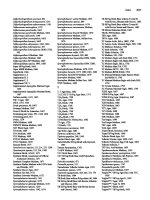Handbook of Psychotherapy Integration, Second Edition Part 1 doc
Bạn đang xem bản rút gọn của tài liệu. Xem và tải ngay bản đầy đủ của tài liệu tại đây (442.24 KB, 57 trang )
Handbook of
Psychotherapy Integration,
Second Edition
John C. Norcross
Marvin R. Goldfried,
Editors
OXFORD UNIVERSITY PRESS
HANDBOOK OF PSYCHOTHERAPY INTEGRATION
OXFORD SERIES IN CLINICAL PSYCHOLOGY
Editorial Board
Larry E. Beutler
Bruce Bongar
Gerald P. Koocher
John C. Norcross
Comprehensive Textbook of Psychotherapy: Theory and Practice
edited by Bruce Bongar and Larry E. Beutler
Clinical Personality Assessment: Practical Approaches, Second
Edition
edited by James N. Butcher
Ethics in Psychology, Second Edition
by Gerald P. Koocher and Patricia Keith-Spiegel
Oxford Textbook of Psychopathology
edited by Theodore Millon, Paul H. Blaney, and Roger D. Davis
Child and Adolescent Psychological Disorders: A Comprehensive
Textbook
edited by Sandra D. Netherton, Deborah Holmes, and C. Eugene
Walker
Handbook of Psychotherapy Integration, Second Edition
edited by John C. Norcross and Marvin R. Goldfried
Handbook of
Psychotherapy Integration
Second Edition
Edited by
John C. Norcross
Marvin R. Goldfried
1
2005
3
Oxford University Press, Inc., publishes works that further
Oxford University’s objective of excellence
in research, scholarship, and education.
Oxford New York
Auckland Cape Town Dar es Salaam Hong Kong Karachi
Kuala Lumpur Madrid Melbourne Mexico City Nairobi
New Delhi Shanghai Taipei Toronto
With offices in
Argentina Austria Brazil Chile Czech Republic France Greece
Guatemala Hungary Italy Japan Poland Portugal Singapore
South Korea Switzerland Thailand Turkey Ukraine Vietnam
Copyright 2003, 2005 by Oxford University Press, Inc.
Published by Oxford University Press, Inc.
198 Madison Avenue, New York, New York 10016
www.oup.com
First edition published in 1992 by Basic Books
Oxford is a registered trademark of Oxford University Press
All rights reserved. No part of this publication may be reproduced,
stored in a retrieval system, or transmitted, in any form or by any means,
electronic, mechanical, photocopying, recording, or otherwise,
without the prior permission of Oxford University Press.
Library of Congress Cataloging-in-Publication Data
Handbook of psychotherapy integration / John C. Norcross, Marvin R. Goldfried,
editors.—2nd ed.
p. cm.
Includes bibliographical references and index.
ISBN-13 978-0-19-516579-1
ISBN 0-19-516579-9
1. Eclectic psychotherapy. I. Norcross, John C., 1957– II. Goldfried, Marvin R.
RC489.E24H36 2005
616.89′14—dc22 2004006513
987654321
Printed in the United States of America
on acid-free paper
Preface
From its beginnings, psychotherapy integration ment was small a nd concentrated in the United
States.has been characterized by a dissatisfaction with
single-school approaches and the concomitant In 2005, psychotherapy integration has en-
tered young adulthood, no longer an immaturedesire to look beyond school boundaries to see
what can be learned—and how patients can or novel approach to clinical work. Eclecti-
cism—or the increasingly favored term, integra-benefit—from other forms of behavior change.
Improving the efficacy, efficiency, and applica- tion—is now well established as the modal ori-
entation of psychotherapists, and this book isbility of psychotherapy is the raison d’e
ˆ
tre of
integration. now only one of many volumes on the subject.
Literally hundreds of books around the globeThe 13 years between publication of the
original edition of the Handbook of Psychother- are now published with the term integrative in
their titles. Empirical evidence attesting to theapy Integration and this second edition was
marked by memorable growth in psychother- effectiveness of integrative psychotherapies is
growing. Integration has grown into a matureapy integration. In 1992, psychotherapy inte-
gration was relatively new and novel, just en- and international movement.
For these and related reasons, the originaltering its pre-teen years. Integration had only
recently crystallized into a formal movement. edition of the Handbook of Psychotherapy Inte-
gration became dated and incomplete. It wasOur original Handbook was the first compila-
tion of the major integrative approaches and time for a new edition.
was hailed by one reviewer as “the bible of the
integration movement.” Few empirical studies OUR AIM
had yet been conducted on the comparative
effectiveness of integrative or eclectic approac hes What has not materially changed is the purpose
of our book. The aim of this second editionto psychotherapy. The formal integration mo ve-
vi
Preface
continues to be a state-of-the-art, comprehen- Psychotherapy Integration (SEPI). Within the
constraints of a printed volume, we have triedsive description of psychotherapy integration
and its clinical practices by some of the leading to share some of that excitement by including
an actual dialogue on psychotherapy integra-proponents. Along with these integrative ap-
proaches, we feature the concepts, history, tion between Paul Wachtel and Marvin Gold-
fried.training, research, and future of psychotherapy
integration as well. The Handbook is divided into five substan-
tive parts. Part I presents the concepts (Nor-The intended audiences are practitioners,
students, and researchers. Psychotherapists of cross) and history (Goldfried, Pachankis, &
Bell) of psychotherapy integration. Part II fea-all persuasions and professions will be attracted
to these premier integrative psychotherapies tures exemplars of each of the movement’s four
predominant thrusts: common factors (Beitman,and integrative trea tment s. The first ed ition of
the Handbook was widely adopted for courses Soth, & Bumby; Miller, Duncan, & Hubble);
technical eclecticism (Lazarus; Beutler, Con-and seminars on psychotherapy integra tion,
and we anticipa te that the second edition wil l soli, & Lane); t heore tical integratio n (Prochaska
& DiClemente; Wachtel, Kruk, & McKinney;again serve this purpose. The contribu tors’
use of the chapter guidelin es (see belo w) and Ryle); and assimilative integration (Stricker &
Gold; Castonguay, Newman, Borkovec, Holt-our addit ion of a summary outline (next sec-
tion) will faci litat e a systematic and compar- forth, & Maramba). Part III presents integrative
psychotherapies for specific disorders and pop-ative analysis of the integrative approaches.
We worked hard t o maintain the delicate bal- ulations—anxiety (Wolfe), chronic depression
(McCullough), borderline personality disorderance between authors’ individual preferences
and readers’ de sire f or uni formi ty in c hapte r (Heard & Linehan), and culturally diverse cli-
ents (Ivey & Brooks-Harris). Part IV featurescon tent a nd format. A nd research ers wi ll find
that each chapter summarizes the empirical integrative treatme nt modalities, specifically, dif-
ferential therapeut ics (C larki n), combini ng the r-evidence assoc iated with that particular ap -
proach. apy formats (Feldman & Feldman), integrative
problem-centered therapy (Pinsof), integrat-
ing spirituality into psychotherapy (Sollod),
and blending pharmacotherapy and psycho-CONTENT AND ORGANIZATION
therapy (Beitman & Saveanu). Part V con-
cludes the volume by addressing clinical train-The contents of this second edition reflect
both the evolution of psychotherapy integra- ing (Norcross & Halgin), outcome research
(Schottenbauer, Glass, & Arnkoff), and futuretion and the continuation of our original goals.
We have deleted several dated chapters that ap- directions (Eubanks-Carter, Burchell, & Gold-
fried) in integration.peared in the original edition, and all remain-
ing chapters have been revised and updated. No single volume—even a hefty one like
this—can canvass all important topics or clini-We added new chapters on outcome-informed
clinical work, cognitive-analytic therapy, cogni- cal situations. One regrettable gap in our cov-
erage is the absence of a chapter on integrativetive-behavioral analysis system of psychother-
apy, integrative psychotherapy with culturally therapy with children and adolescents. We could
not readi ly identify a conceptually advanceddiverse clients, integrative problem-centered
therapy, and blending spirituality with psycho- and empirically supported integrative therapy
for children. Moreover, space considerations re-therapy. An entirely new section (with two
chapters) features assimilative integration. We stricted us to four examples of integrative thera-
pies for specific disorders and populations. Inhave also tried to convey more about the pro-
cess of integrative dialogue itself—the lively making the precarious choices of which mate-
rial would receive coverage and which wouldand dynamic exchanges that often occur in in-
tegrative meetings, particularly the annual con- be passed over, we opted to keep the book clin-
ically useful and student accessible.ferences of the Society for the Exploration of
Preface
vii
CHAPTER GUIDELINES Applicability and Structure
Aim: To describe those situations and patients
for which the approach are particularlyContributors to Part II (Integrative Psychother-
apy Models) and Part III (Integrative Psycho- relevant.
• For which types of patients (e.g., diagnos-therapies for Specific Disorders and Popula-
tions) were asked to address a list of central tic types, client characteristics) is the ap-
proach relevant?topics in their chapters. Chapter guidelines
were designed to facilitate comparative analy- • For which types of patients is the ap-
proach not appropriate or of uncertainses and to ensure comprehensiveness. As ex-
pected, the authors did not always use the sug- relevance?
• For what situations (e.g., clinical settings,gested headings; all of the requested topics
were addressed in the respective chapters, but time limitations) is/is not the approach
relevant?we did not insist on identical formats.
• What are the clinical settings for the ap-
The Integrative Approach
proach? Are there any contraindicated
Aim: To outline the historical development
settings?
and guiding principles of the approach.
• What is the typical frequency and length
• What were the primary influences that
of sessions?
contributed to the development of the ap-
• Is the therapy typically time-limited or
proach (e.g., people, experiences, re-
unlimited? What is the typical duration
search, books, conferences)?
of therapy (mean number and range of
• What were the direct antecedents of the
sessions)?
approach?
• Are combined therapy formats used (e.g.,
• What are the guiding principles and cen-
individual therapy plus family therapy)?
tral tenets of your approach?
• Where does psychotropic medications fit
• Are some theoretical orientations more
into the approach?
prominent contributors to your approach
than others?
Processes of Change
• What is the basis for selecting therapy in-
Aim: To identify the mechanisms or processes
terventions (e.g., proven efficacy, theoreti-
that produce changes in therapy and to
cal considerations, clinical experience)?
assess their relative impact.
• What is the role of insight and under-Assessment and Formulation
Aim: To describe the methods used to under- standing in change, distinguishing be-
tween historical-genetic insight and inter-stand patient functioning, to construct a
case formulation, and to prioritize treat- actional insight?
• What is the relative importance of in-ment goals.
• What are the formal and informal systems sight/awareness, skill/action acquisition,
transference analysis, and the therapeuticfor diagnosing or typing patients?
• Do you employ tests or questionnaires in alliance in the approach?
• What are the relative contributions ofyour assessment?
• What major client and/or environmental “common” factors to outcome?
• Does the therapist’s personality and psy-variables are assessed?
• At which levels (e.g., individual, dyadic, chological health play an important role?
• What other therapist factors influence thesystem) are the assessments made?
• How do you integrate assessment and course and outcome of therapy?
• Which patient variables enhance or limittreatment?
• What role does case formulation play in the probability of successful treatment?
the approach?
• How do you select and prioritize treat- Therapy Relationship
Aim: To depict the therapeutic relationshipment goals?
viii
Preface
valued in the approach and the therapist Cases in Part III will pertain, of course,
to the specific disorder discussed in thebehaviors contributing to it.
• How do you view the therapeutic rela- respective chapters.
tionship (e.g., a s a precon ditio n of ch ange,
Empirical Research
as a mechanism of change, as content to
Aim: To summarize the empirical research on
be changed)?
the approach.
• What are the most important ingredients
• What research has been conducted on
of the therapy relationship in the ap-
the conceptual framework of the approach?
proach?
• What empirical evidence exists for the
• On what grounds is the therapy relation-
efficacy and effectiveness o f the approach?
ship adjusted or tailored to the individual
• What are the percentages of dropouts and
patient?
negative outcomes?
• Does the therapist’s role change as ther-
apy progresses?
Future Directions
Aim: To explicate the future directions and
Methods and Techniques
needs of the approach.
Aim: To delineate the methods and tech-
• What further work (clinical, research,
niques frequently employed in the ap-
theoretical, training) is required to ad-
proach.
vance your approach?
• What are some of the interventions used
• In what directions is your approach head-
to engage patients?
ing in the next decade?
• What is the therapist’s work in treatment?
What is the client’s work in treatment?
ACKNOWLEDGMENTS
• What therapy methods are typically em-
ployed? Which would typically not be
A large and integrative volume of this nature
used?
requires considerable collaboration. Our efforts
• How do you deal with resistances and
have been aided immeasurably by our families
blocks in treatment?
and our SEPI colleagues; the former giving us
• What are the most common and the most
time and inspiration, the latter providing intel-
serious technical errors a therapist can
lectual stimulation and professional affirma-
make when operating within your ap-
tion.
proach?
We are truly indebted to the contributors.
• How active and directive is the therapist
Most of them are SEPI members, and all are
in the approach?
eminent psychotherapists in their own right.
• How are maintenance sessions and re-
They are “beyond category”—a phrase that
lapse preventi on addressed in th e approach?
Duke Ellington used as a high form of praise
for artists who transcend the normal theoretical
Case Example
boundaries. We are pleased to be in their com-
Aim: To illustrate the initiation, process, and
pany and to privilege their integrative work.
outcome of the integrative approach with
Finally, we reciprocally acknowledge each
a single case example.
other for the pleasure and success of our edito-
• To maintain comparability among the ex-
rial collaboration. We have a long history of
amples, the cases in Part II should deal
collaborating on various projects and consider
with the treatment of a client with gen-
ourselves fortunate to continue to do so.
eral anxiety and unipolar depression (psy-
chological distress). The case example
John C. Norcross
should illustrate and discuss the initiation
Clarks Summit, PA
of treatment, patient assessment, case for-
mulation, treatment methods, therapy Marvin R. Goldfried
Stony Brook, NYrelationship, termination, and outcome.
Contents
Summary Outline xiii
About the Editors xv
Contributors xvii
Part I: Conceptual and Historical Perspectives
1. A Primer on Psychotherapy Integration 3
John C. Norcross
2. A History of Psychotherapy Integration 24
Marvin R. Goldfried, John E. Pachankis, and Alissa C. Bell
Part II: Integrative Psychotherapy Models
A. Common Factors
3. The Future as an Integrating Force Through the Schools of Psychotherapy 65
Bernard D. Beitman, Angela M. Soth, and Nancy A. Bumby
4. Outcome-Informed Clinical Work 84
Scott D. Miller, Barry L. Duncan, and Mark A. Hubble
x
Contents
B. Technical Eclecticism
5. Multimodal Therapy 105
Arnold A. Lazarus
6. Systematic Treatment Selection and Prescriptive Psychotherapy 121
Larry E. Beutler, Andres J. Consoli, and Geoffrey Lane
C. Theoretical Integration
7. The Transtheoretical Approach 147
James O. Prochaska and Carlo C. DiClemente
8. Cyclical Psychodynamics and Integrative Relational Psychotherapy 172
Paul L. Wachtel, Jason C. Kruk, and Mary K. McKinney
9. Cognitive Analytic Therapy 196
Anthony Ryle
D. Assimilative Integration
10. Assimilative Psychodynamic Psychotherapy 221
George Stricker and Jerry Gold
11. Cognitive-Behavioral Assimilative Integration 241
Louis G. Castonguay, Michelle G. Newman, Thomas D. Borkovec, Martin Grosse Holtforth,
and Gloria G. Maramba
Part III: Integrative Psychotherapies for Specific Disorders & Populations
12. Integrative Psychotherapy of the Anxiety Disorders 263
Barry E. Wolfe
13. Cognitive Behavioral Analysis System of Psychotherapy (CBASP) for Chronic
Depression 281
James P. McCullough, Jr.
14. Integrative Therapy for Borderline Personality Disorder 299
Heidi L. Heard and Marsha M. Linehan
15. Integrative Psychotherapy with Culturally Diverse Clients 321
Allen E. Ivey and Jeff E. Brooks-Harris
Part IV: Integrative Treatment Modalities
16. Differential Therapeutics 343
John F. Clarkin
17. Integrating Therapeutic Modalities 362
Larry B. Feldman and Sandra L. Feldman
18. Integrative Problem-Centered Therapy 382
William M. Pinsof
19. Integrating Spirituality with Psychotherapy 403
Robert N. Sollod
Contents
xi
20. Integrating Pharmacotherapy and Psychotherapy 417
Bernard D. Beitman and Radu V. Saveanu
Part V: Training, Research, and Future Directions
21. Training in Psychotherapy Integration 439
John C. Norcross and Richard P. Halgin
22. Outcome Research on Psychotherapy Integration 459
Michele A. Schottenbauer, Carol R. Glass, and Diane B. Arnkoff
23. A Critical Dialogue on Psychotherapy Integration 494
Paul L. Wachtel and Marvin R. Goldfried
24. Future Directons in Psychotherapy Integration 503
Catherine Eubanks-Carter, Lisa A. Burckell, and Marvin R. Goldfried
Name Index 523
Subject Index 538
This page intentionally left blank
Summary Outline (for Parts II and III)
Integrative Approach
Assessment and Formulation
Applicability and Structure
Processes of Change
Therapy Relationship
Methods and Techniques
Case Example
Empirical Research
Future Directions
Common Factors
Future as Integrating Force 65 69 70 72 72 74 80 82 82
Outcome-Informed Clinical Work 85 90 90 92 94 91 95 86 98
Technical Eclecticism
Multimodal Therapy 105 107 111 — 117 109 112 117 118
Systematic Treatment Selection 121 125 123 129 130 132 133 134 139
Theoretical Integration
Transtheoretical Therapy 148 154 155 157 157 — 158 162 167
Cyclical Psychodynamics 173 — 179 177 180 178 181 185 189
Cognitive-Analytic Therapy 196 198 199 203 204 206 209 211 213
Assimilative Integration
Assimilative Psychodynamic Therapy 221 223 225 226 229 231 234 236 237
CBT Assimilative Integration 242 245 244 246 247 248 254 256 257
Specific Disorders & Populations
Anxiety Disorders 263 271 272 272 274 275 275 277 277
Chronic Depression 281 283 284 285 288 286 291 294 295
Borderline Personality Disorder 300 304 303 312 313 307 314 316 317
Culturally Diverse Clients 321 322 326 327 328 329 331 333 334
xiii
This page intentionally left blank
About the Editors
J
OHN
C. N
ORCROSS
, Ph.D., is Professor of Psy- M
ARVIN
R. G
OLDFRIED
, Ph.D., is Distinguished
Professor of Psychology and Professor of Psychia-chology and Distinguished University Fellow
at the University of Scranton and a clinical psy- try at the State University of New York at Stony
Brook. In addition to his teaching, clinical super-chologist in part-time practice. Author of more
than 200 scholarly publications, Dr. Norcross vision, and research, he maintains a limited
practice of psychotherapy in New York City. Dr.has co-written or edited fourteen books, includ-
ing Psychotherapy Relationships That Work, Goldfried is the recipient of the American Psy-
chological Association (APA) Distinguished Psy-Psychologists’ Desk Reference (with Gerald P.
Koocher and Sam S. Hill), Authoritative Guide chologist Award for Contributions to Knowl-
edge. He received Distinguished Psychologistto Self-Help Resources in Mental Health, and
Systems of Psychotherapy: A Transtheoretical awards from APA’s divisions of clinical psychol-
ogy; general psychology; lesbian, gay, and bi-Analysis (with James O. Prochaska). He is Pres-
ident of the International Society of Clinical sexual issues; and psychotherapy. He also re-
ceived the Award for Clinical ContributionsPsychology, past-President of the APA Division
of Psychotherapy, and Council Representative from the Ass ociat ion for Advancement of Behav-
ior Therapy. He is past-President of the Societyof the American Psychological Association
(APA). Dr. Norcross is also editor of Journal of for Psychother apy Research; founder o f the jour-
nal In Session: Psychotherapy in Practice;andClinical Psychology: In Session and has been
on the editorial boards of a dozen journals. His author or editor of se veral books , including
Clinical Behavior Therapy (with Gerald C. Da v-professional awards include the Pennsylvania
Professor of the Year from the Carnegie Foun- ison), Converging Themes in Psychotherapy:
From Cognitive-Behavior Therapy to Psychother-dation, APA’s Distinguished Contributions to
Education and Training Award, the Rosalee apy Integration, and How Therapists Change.
Dr. Goldfried is cofounder of the Society for theWeiss Award from the American Psychological
Foundation, and election to the National Exploration of Psychotherapy In tegra tion (SEPI)
and founder of AFFIRM: Psychologists Affirm-Academies of Practice.
ing Their Gay, L esbia n, and Bisexual Family.
xv
This page intentionally left blank
Contributors
D
IANE
B. A
RNKOFF
N
ANCY
A. B
UMBY
Department of PsychiatryDepartment of Psychology
Catholic University of America University of Missouri at Columbia
L
ISA
A. B
URCKELL
B
ERNARD
D. B
EITMAN
Department of Psychiatry Department of Psychology
State University of New York at Stony BrookUniversity of Missouri at Columbia
A
LISSA
C. B
ELL
L
OUIS
G. C
ASTONGUAY
Department of PsychologyDepartment of Psychology
State University of New York at Stony Brook Pennsylvania State University
J
OHN
F. C
LARKIN
L
ARRY
E. B
EUTLER
Pacific Graduate School of Psychology and Department of Psychiatry
Weill Medical College of Cornell UniversityUniversity of California at Santa Barbara
T. D. B
ORKOVEC
A
NDRES
J. C
ONSOLI
Department of CounselingDepartment of Psychology
Pennsylvania State University San Francisco State University
C
ARLO
C. D
I
C
LEMENTE
J
EFF
E. B
ROOKS
-H
ARRIS
Counseling and Student Development Center Department of Psychology
University of Maryland at Baltimore CountyUniversity of Hawaii at Manoa
xvii
xviii
Contributors
B
ARRY
L. D
UNCAN
J
ASON
C. K
RUK
Department of PsychologyInstitute for the Study of Therapeutic Change
Chicago, Illinois City University of New York
C
ATHERINE
E
UBANKS
-C
ARTER
G
EOFFREY
L
ANE
Department of Psychology
Pacific Graduate School of Psychology
State University of New York at Stony Brook
Palo Alto, CA
L
ARRY
B. F
ELDMAN
A
RNOLD
A. L
AZARUS
Adjunct Faculty
Rutgers University and Center for Multimodal
Lake Michigan College
Psychological Services
S
ANDRA
L. F
ELDMAN
M
ARSHA
M. L
INEHAN
Adjunct Faculty
Department of Psychology
Lake Michigan College
University of Washington
C
AROL
R. G
LASS
G
LORIA
G. M
ARAMBA
Department of Psychology
Department of Psychology
Catholic University of America
Pennsylvania State University
J
ERRY
G
OLD
J
AMES
P. M
C
C
ULLOUGH
,J
R
.
Department of Psychology
Departments of Psychology and Psychiatry
Adelphi University
Virginia Commonwealth University
M
ARVIN
R. G
OLDFRIED
M
ARY
K. M
C
K
INNEY
Department of Psychology
Department of Psychology
State University of New York at Stony Brook
University of North Carolina at Chapel Hill
R
ICHARD
P. H
ALGIN
S
COTT
D. M
ILLER
Department of Psychology
Institute for the Study of Therapeutic Change
University of Massachusetts at Amherst
Chicago, Illinois
H
EIDI
L. H
EARD
M
ICHELLE
G. N
EWMAN
Senior Consultant
Department of Psychology
British Isles DBT Training
Pennsylvania State University
M
ARTIN
G
ROSSE
H
OLTFORTH
J
OHN
C. N
ORCROSS
Department of Psychology
Department of Psychology
University of Bern
University of Scranton
M
ARK
A. H
UBBLE
J
OHN
E. P
ACHANKIS
Institute for the Study of Therapeutic Change
Department of Psychology
Chicago, Illinois
State University of New York at Stony Brook
A
LLEN
E. I
VEY
University of Massachusetts at Amherst and W
ILLIAM
M. P
INSOF
The Family Institute Northwestern UniversityMicrotraining Associates
Contributors
xix
J
AMES
O. P
ROCHASKA
A
NGELA
M. S
OTH
Department of Psychiatry and NeurologyDepartment of Psychology
University of Rhode Island University of Missouri at Columbia
G
EORGE
S
TRICKER
A
NTHONY
R
YLE
Department of Psychiatry Department of Psychology
Adelphi UniversityGuy’s Hospital, London
R
ADU
V. S
AVEANU
P
AUL
L. W
ACHTEL
Department of PsychologyDepartment of Psychiatry
Ohio State University City College and the Graduate Center of the
City University of New York
M
ICHELE
A. S
CHOTTENBAUER
Department of Psychology B
ARRY
E. W
OLFE
Argosy UniversityCatholic University of America
Washington, DC
R
OBERT
N. S
OLLOD
Department of Psychology
Cleveland State University
This page intentionally left blank
PART I
Conceptual and Historical Perspectives
This page intentionally left blank
1
A Primer on Psychotherapy Integration
JOHN C. NORCROSS
Rivalry among theoretical orientations has a growth of our knowledge, but the active inter-
play of various tenaciously held views.”long and undistinguished history in psycho-
therapy, dating back to Freud. In the infancy of As the field of psychotherapy has matured,
integration, or eclecticism, has become a thera-the field, therapy systems, like battling siblings,
competed for attention and affection in a “dog- peutic mainstay. Since the early 1990s, we
have witnessed both a general decline in ideo-ma eat dogma” environment (Larson, 1980).
Clinicians traditionally operated from within logical struggle and the movement toward rap-
prochement. Psychotherapists now acknowl-their own particular theoretical frameworks, of-
ten to the point of being blind to alternative edge the inadequacies of any one theoretical
system and the potential value of others. Whatconceptualizations and potentially superior in-
terventions. Mutual antipathy and exchange of is distinctive of the present era is tolerance for
and assimilation of formulations that werepuerile insults between adherents of rival ori-
entations were very much the order of the day. once viewed as deviant. Indeed, many young
students of psychotherapy express sur prise whenThis ideological cold war may have been a
necessary developmental stage toward sophisti- apprised of the ideological cold war of the pre-
ceding generations.cated attempts at rapprochement. Kuhn (1970)
has described this period as a pre-paradigmatic Psychotherapy integration has crystallized
into a formal movement or, more dramatically,crisis. Feyerabend (1970, p. 209), another phi-
losopher of science, concluded that “the in- a “revolution” (Lebow, 1997) and a “metamor-
phosis” i n mental health (L ondon , 1988; Moul-terplay between tenacity and proliferation is
an essential feature in the actual development trup, 1986). Although various labels are applied
to this movement—eclecticism, integration,of science. It seems that it is not the puzzle-
solving activity that is responsible for the rapprochement—the goals are similar. Psycho-
3
4
Conceptual and Historical Perspectives
therapy integration is characterized by dissatis- single unification scheme is best. Although it
might be more satisfying and elegant if the psy-faction with single-school approaches and a
concomitant desire to look across school bound- chotherapy world were not a multiverse but
rather a universe, the pluralists assure us thataries to see what can be learned from other
ways of conducting psychotherapy. The ulti- this quest will not be realized, at least not soon
(Messer, 1992). In the meantime, psychother-mate outcome of doing so is to enhance the
efficacy, efficiency, and applicability of psycho- apy is progressing toward integration in the
zeitgeist of informed pluralism.therapy.
A number of indicators attest to the maturity
of psychotherapy integration. Eclecticism,or
the more favored term integration, is the modal PLAN OF THE CHAPTER
theoretical orientation of English-speaking psy-
chotherapists . Leading psychotherapy textbooks This chapter explicates the broad context of
psychotherapy integration and sets the stage forroutinely identify their theoretical persuasion
as eclectic, and an integrative or eclectic chap- the subsequent chapters in the volume. As the
chapter title indicates, I offer a primer on inte-ter is regularly included in compendia of treat-
ment approaches. The publi catio n of b o oks that gration: in the dual sense of a primer (soft i)as
a small introduction to the subject and of asynthesize various therapeutic concepts and
methods continues unabated, now numbering primer (hard i) as a basecoat or undercoat for
the following applications. This chapter beginsin the hundreds. Handbooks on integration,
such as this one, have been published in at by describing the converging reasons for the
growth of psychother apy integra tion, after whichleast six countries. Reflecting and engendering
the movement have been the establishment of I review four predominant routes to integra-
tion. This segues into a brief consideration ofinterdisciplinary organizations devoted to inte-
gration, notably the Society for the Exploration the varieties of integration, which includes
summaries of recent studies on the prevalenceof Psychotherapy Integration (SEPI), and of
international publications, including SEPI’s and subtypes of eclectic/integrative therapies.
The chapter concludes with a discussion of re-Journal of Psychotherapy Integration. And the
integrative fervor will apparently persist well current obstacles to psychotherapy integration.
into the 2000s: A recent panel of psychother-
apy experts did portend its escalating popu-
larity into the new millennium (Norcross, WHY INTEGRATION NOW?
Hedges, & Prochaska, 2002).
Although psychotherapy integration has in- Integration as a point of view has probably ex-
isted as long as philosophy and psychotherapy.deed come of age, we have not yet attained
consensus or convergence. As Lazarus (this vol- In philosophy, the third-century biographer Di-
ogenes Laertius referred t o an eclectic schoolume) notes, the field of psychotherapy is still
replete with cult members; devoted followers that flourished in Alexandria in the second
century
A.D.
(Lunde, 1974). In psychotherapy,of a particular school of thought. High priests
of psychological health are still engaged in com- Freud consciously struggled with the selection
and integration of diverse methods (Frances,petitive strife and internecine battles. These
battles have receded but not extinguished, par- 1988).
More formal ideas on synthesizing the psy-ticularly in countries outside North America
and Western Europe. chotherapies appeared in the literature as early
as the 1930s (Goldfried, Pachankis, & Bell, thisA consensus has been achieved, however, in
support of the idea that neither traditional frag- volume). For example, Thomas French (1933)
stood before the 1932 meeting of the Americanmentation nor premature unification will wise-
ly serve the field of psychotherapy or its clients. Psychiatric Association and drew parallels be-
tween certain concepts of Freud and Pavlov; inWe are in no position to determine conclu-
sively which single theory, single treatment, or 1936, Sol Rosenzweig published an article that









